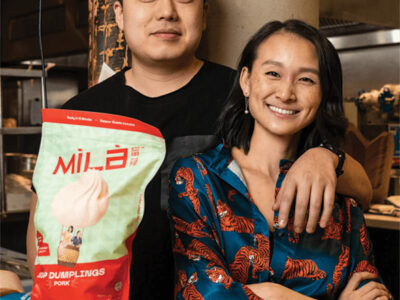
Class of ’73 | It was at a recent dinner party that Susan Rodriguez CW’73, sharing in the night’s bonhomie, prepared to sip a glass of South African Pinotage. The moment soured at the first metallic whiff of Brettanomyces—or Brett—a yeast that, in high levels, has sent more than a few bottles of wine down the kitchen drain.
“Some people say it smells like a wet dog in a phone booth, or a sweaty saddle,” says Rodriguez, director of the Wine Sensory Lab at California State University’s Fresno campus. “It reminds me of a Band-Aid, or dirty socks. I couldn’t drink it. Luckily, everyone was talking enough that they weren’t paying attention to me. I didn’t want to come across as a wine snob, but it was not good.”
Rodriguez would know. For the past 11 years, she’s been the arbiter of taste at Fresno State Winery, the nation’s first bonded winery on a university campus. Students produce 100,000 bottles a year of 20 varietals and blends—but not before they hone their noses and train their palates under Rodriguez’s tutelage.
Every year, more than 100 students pass through her lab, located at the university’s Viticulture and Enology Research Center. They do their work in the heart of California’s Central Valley, the nation’s most productive agricultural region.
The body of sensory science knowledge has exploded in the last two decades, leading winemakers to demand ever-higher quality controls in the high-stakes world of enology. (Even herbicide and fungicide manufacturers call on Rodriguez to help determine whether their products will affect a wine’s taste.) Each year she convenes “descriptive analysis panels” made up of students and community members to judge wine merits, or demerits.
“Some people say good wine is made in the vineyard. I don’t believe that 100 percent,” says Rodriguez, who earned her bachelor’s degree in biology at Penn. Wine can become tainted at any stage of the production process.
“Even in good wineries, you’ll take a tour and smell rotten eggs,” she says. “That means the yeast is running out of food. You want to make sure the yeast is happy and does its total fermentation. Maybe a hundred years ago, wineries didn’t have quality controls. They would let wine ferment spontaneously. Some would turn out well and some they’d throw down the drain. Now, we try to throw nothing down the drain. You’re on top of it always, monitoring it chemically. I try to teach students all the things they should smell for in a winery.”
Rodriguez works at Fresno State with her husband of 26 years, Roy Thornton, professor of enology. The couple courted while Rodriguez was studying wine yeast genetics in New Zealand. They later collaborated at E. & J. Gallo Winery in Modesto, California. As research microbiologists, the pair became experts in a then little-practiced process known as flow cytometry, in which a laser determines the number and health of yeast microorganisms during wine fermentation.
Rodriguez earned a doctorate in microbiology from the University of California, Davis. After tiring of studying salmonella genetics, she decided to take an introductory enology course at the university. Her interest was piqued, in spite of not knowing the first thing about wine.
Back in the sensory lab, Rodriguez subjects her students’ taste buds to a veritable boot camp. They first paint their tongues with blue food coloring so that classmates equipped with magnifying glasses can count the number of papillae—or taste buds—that coat the tongue. They then lick paper strips soaked in a chemical compound called 6-n-propylthiouracil, which reveals their genetic predisposition to taste bitterness.
“There are students who say, ‘You ruined my day. I tasted bitter all the way until dinner.’ And then there are people who say, ‘I can’t taste that,’” Rodriguez says. “Sensitivities and genetic thresholds are just so different. You might smell something and I might not.”
In another exercise, students are taught the distinctive roles of taste and smell by trying to guess the flavor of 10 jelly beans while holding their noses. “They should sense only the sugar and the acid on their tongue,” Rodriguez says. “Then they release their nose and all of a sudden they can ‘smell’ the jelly bean—licorice, pear, and bubblegum.”
While most people can detect four of the five basic tastes in food and drink—sweet, salty, bitter, and sour—the fifth taste, umami (Japanese for “savory”) is less commonly discerned. Rodriguez describes umami as “a bouillon taste.” It’s more prevalent in red wines.
“It’s not an easy taste because it’s not something that people grow up thinking about,” she says.
Taste, it turns out, isn’t all that it seems. “The hardest thing for me to teach is differentiating taste and smell,” says Rodriguez, noting that there are 10,000 aromas. “Just because something is in your mouth doesn’t mean you taste it. Strawberry is not a taste; it’s a smell. There’s no receptor for strawberry on your tongue. That’s hard for people to understand.”
What’s not hard to understand is that Rodriguez is working to make your next dinner party a memorable one. Millions of wine lovers will drink to that.
—Andrew Faught




